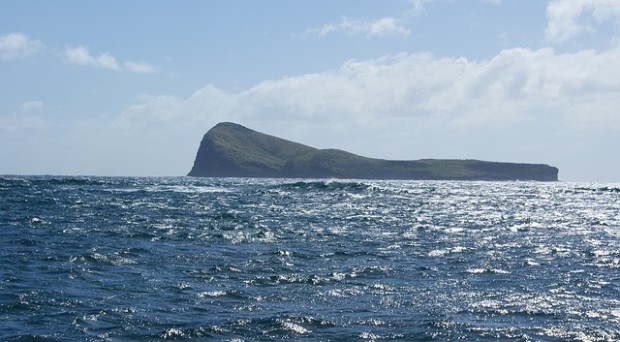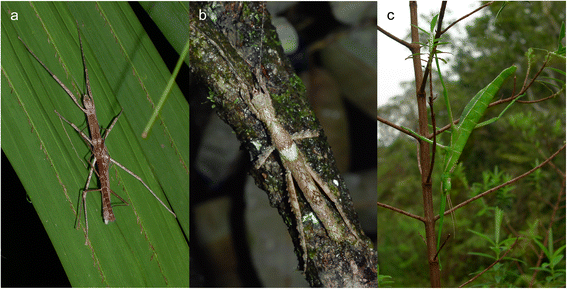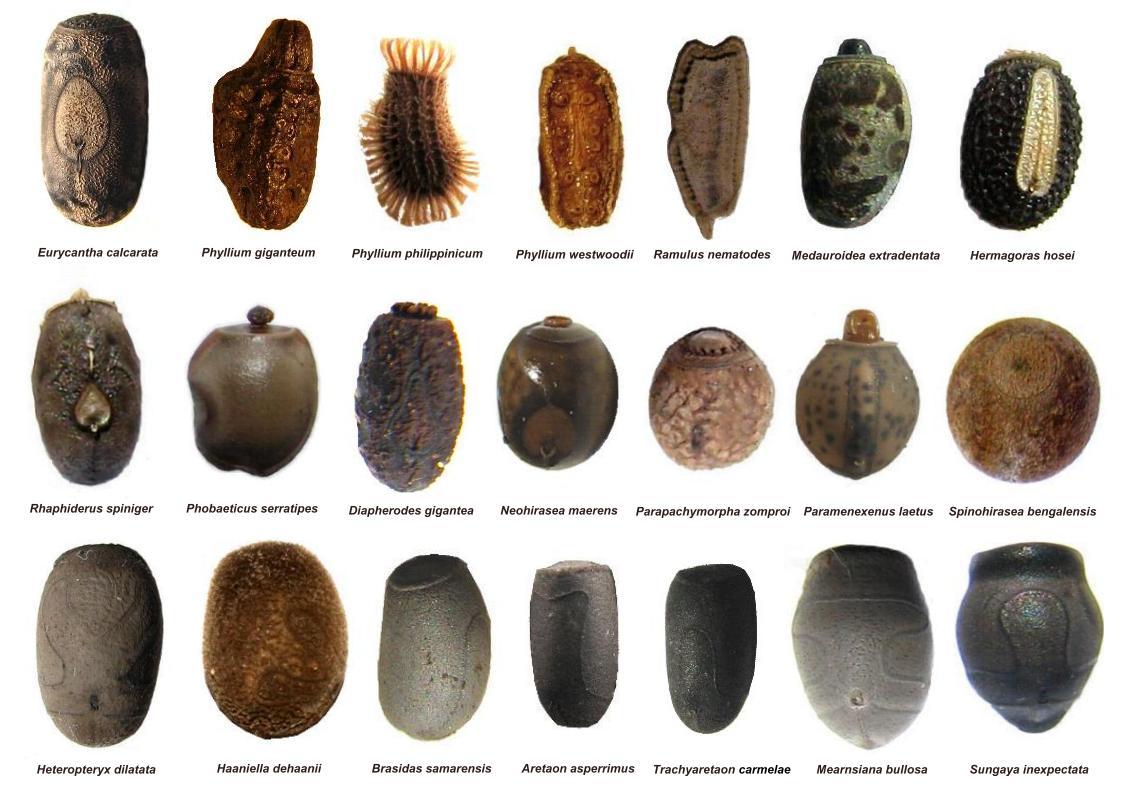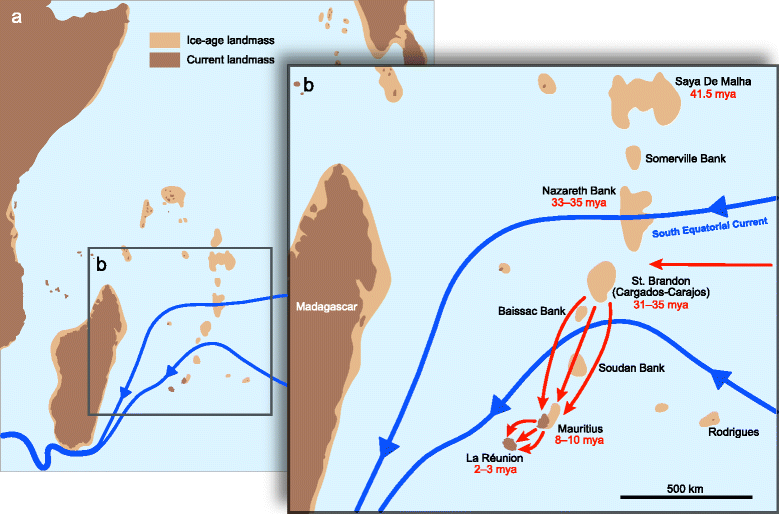
From out of the depths
Volcanic islands, as newly formed lands emerging from the ocean depths, are often sources of evolutionary novelties. Effectively blank canvases when they first appear, plants and animals that find their way to these new islands often evolve into unique forms.
The Mascarene islands – Mauritius, Réunion and Rodrigues – are excellent examples of such places. Having arisen off the coast of East Africa relatively recently (compared to other nearby islands like Madagascar and the Seychelles) thousands of unique species of plants and animals have since evolved on these islands.
While many of these species have not survived contact with human settlers in recent centuries (including, famously, the Dodo), the Mascarenes are still home to some of the world’s most unique wildlife.
All of these species evolved from ancestors that, by some chance, found their way to these remote islands long ago: a bird blown off course by a storm, a seed floating across the ocean, etc. Such events are unlikely, but over the course of millions of years occur enough for the islands to be colonized many times by different founder species.
Naturally though, we would expect these colonizers to have come from the lands closest to the Mascarene islands. This is indeed the case for the vast majority of species on the islands, whose closest ancestors are found in Madagascar or East Africa.
This makes the findings of new research on the origins of the Mascarene stick insects, published this week in BMC Evolutionary Biology, all the more surprising. They suggest that the ancestors of these species came to the islands not from nearby Africa, but from Australasia – over 5000km away.

Stick insect ancestries
The researchers, led by Thomas Buckley at the University of Auckland in New Zealand, extracted and sequenced DNA from 38 stick insect species (including nearly all known species from Mauritius and Réunion) and combined this data with known sequences from 83 other species. A phylogenetic tree was then created to estimate the evolutionary relationships between these species.
The assembled data represents the most comprehensive study of stick insect evolution yet; it is also the first study to include species sampled from Indian Ocean islands. The overall pattern of stick insect evolution matches that seen in previous studies. However the results on the evolutionary origins of the Mascarene stick insects were rather more surprising.
The Mascarene stick insects show a remarkable level of diversity in both appearance and behaviour. Based on this diversity they can be roughly ordered into five very different groups. Notably these different groups strongly resemble stick insects groups found in Madagascar and Africa. Understandably then, taxonomists have long assumed that the five groups of Mascarene stick insects are unrelated to each other and originated from five different colonizations of the islands.
Yet the researchers results strongly support a single common ancestor for all Mascarene stick insects; that is, the incredibly diverse assemblage of species found on the islands have all evolved from one original colonizing species. The apparent similarities with mainland stick insects do not represent shared evolutionary histories but are instead remarkable examples of convergent evolution.
Stick insects sailings
While this is an unexpected finding, even more extraordinary is what the results tell us about the origins of this original colonizing species. The evolutionary tree strongly places the Mascarene stick insects as most closely related to stick insects from Australasia. Instead of making the relatively short trip from nearby Madagascar, the original founding species reached the Mascarenes by traveling over 5000km across the Indian Ocean.
How could a stick insect (which generally are poor fliers) travel such a long distance? Most likely, stick insect eggs, which are hard-shelled and seed like, floated along the ocean currents, whether directly in the water or attached to twigs or other plant material. Recent research has shown that modern day stick insect eggs can survive for several months while floating on seawater.

While the odds of a stick insect egg successfully surviving this journey (and then successfully thriving on the island it washes up on) are surely remote, it only needs to happen once for a species to establish itself on a new island. Indeed such long voyages have happened multiple times in evolutionary history. Other recent research suggests that stick insects in the Seychelles also originate from Australasia, while geckos and skinks found in the Mascarenes seem to have made the same journey.
Voyaging to an island that doesn’t yet exist
As if this story were not amazing enough, the researchers also estimate that stick insects arrived in the Mascarene islands around 20 million years ago. Geological records show that Mauritius emerged from the sea only 8-10 million years ago, while Réunion and Rodrigues are much younger still. The Mascarene stick insects then, are older than the land they live on.
How can this be? The authors believe that the founding stick insects must originally have arrived on nearby islands that were above sea level at this time but have since sunk back beneath the waves. Indeed the geological record finds plenty of evidence for such older islands having existed as recently as the last ice age.

The founding stick insects washed up on these now vanished islands and likely it is here that they evolved into most of the numerous forms found today; these islands seem to have been much larger than the modern day Mascarenes, which would have provided better conditions for speciation. As these islands gradually sank beneath the waves and first Mauritius and later Réunion and Rodrigues appeared, the stick insects moved across to the newer lands where we find them today.
The story of the Mascarene stick insects is an extraordinary one. From a few eggs that sailed thousands of miles across the ocean and washed up on a distant island that no longer exists, have evolved the numerous forms of most dazzling diversity we admire today.
Comments